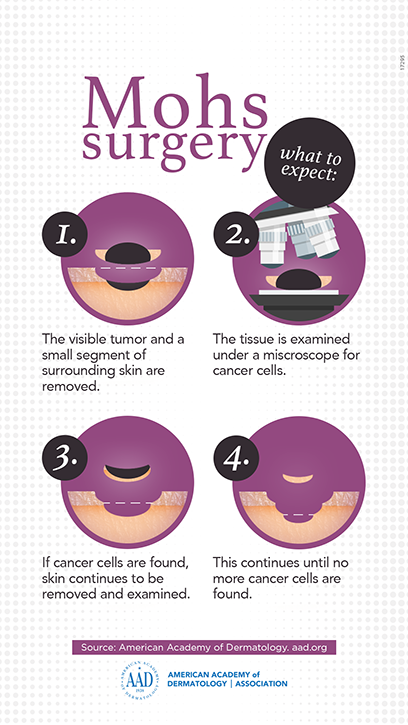Mohs Surgery
Mohs surgery (also called Mohs micrographic surgery) is used to treat skin cancer. This surgery is performed by a specially trained Mohs surgeon and has a unique benefit beyond traditional surgery or excisions. During surgery, the surgeon can see where the cancer stops. This isn’t possible with other types of treatment for skin cancer. The ability to see where the cancer stops gives Mohs surgery two important advantages: 1) a high cure rate and 2) allowing you to keep as much healthy skin as possible because the surgeon only removes the skin with cancer cells. This is especially important when skin cancer develops in an area with little tissue beneath it, like an eyelid, ear, or nose.
Most Mohs surgery patients have a common type of skin cancer like basal cell carcinoma (BCC) or squamous cell carcinoma (SCC). No matter what type of skin cancer you have, Mohs surgery is only recommended for certain patients. It is usually recommended when a BCC or SCC is aggressive or large, appears in an area with little tissue beneath it (eyelid, nose, ear, scalp, genitals, hand, or foot) or was treated before and has returned.
During Mohs surgery, most patients remain awake and alert, meaning it can safely be performed in a medical office or surgical suite. On the day of the surgery, your surgeon will first examine the area to be treated. You’ll then be prepped for surgery. This includes giving you an injection of anesthetic. This injection only numbs the area that will be operated on, so you’ll be awake during the surgery. The surgeon starts by first cutting out the visible skin cancer. Next, the surgeon removes a thin layer of surrounding skin. You’re then bandaged so that you can wait comfortably while the Mohs surgeon looks at the removed skin under a microscope. The surgeon is looking for cancer cells. If cancer cells are found, you’ll need another layer of skin removed. Once cancer cells are no longer seen, your surgeon will decide how to treat your wound. Some wounds heal nicely without stitches. Others need stitches. To minimize the scar and help the area heal, some patients require a skin graft or other type of surgery. If you need wound treatment, your Mohs surgeon may treat the wound that same day.
Frequently Asked Questions: Mohs Surgery
- What distinguishes Mohs surgery from traditional skin cancer excisions? Mohs surgery offers a distinctive advantage by allowing the surgeon to visualize the cancer extent during the procedure. This precision leads to a higher cure rate and minimal disruption to healthy skin.
- What types of skin cancer can be treated with Mohs surgery? Our Mohs surgery specialists are experienced in treating various skin cancer types, such as basal cell carcinoma (BCC) and squamous cell carcinoma (SCC), among others.
- Is Mohs surgery performed under general anesthesia? No, Mohs surgery is typically performed using local anesthesia, ensuring patient comfort and safety throughout the procedure.
- How does Mohs surgery minimize scarring? Mohs surgery’s targeted approach preserves healthy skin, leading to reduced scarring. Techniques like stitches or skin grafts may be used to optimize wound healing and minimize cosmetic impact.
- Can Mohs surgery be performed on delicate areas like the eyelids or nose? Yes, Mohs surgery is particularly valuable for treating skin cancer in delicate areas with limited tissue, such as the eyelids, nose, and ears, due to its precise cancer removal capabilities.”



